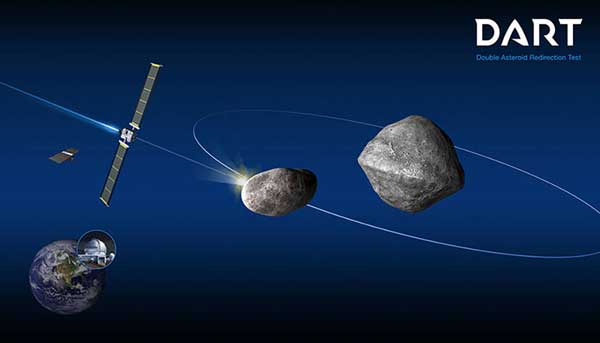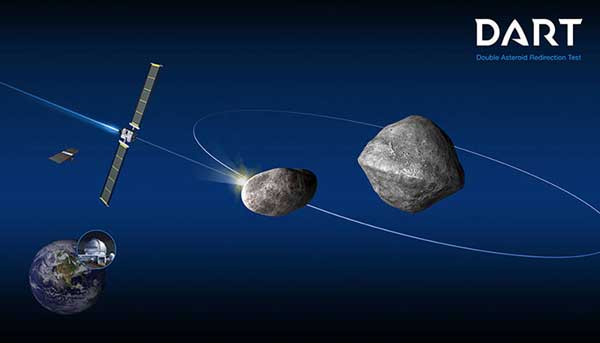
Spanish Astrobiology Center Participates in DART and Hera Planetary Defense Missions (Image Credit: SNN)
MADRID (Spanish Astrobiology Center) — Currently the Astrobiology Center (CAB, CSIC-INTA) is an integral part of the joint space mission of NASA and ESA called DART-Hera. Its objective consists of sending two spacecraft to a binary asteroid system known as Didymos 65803 and thus validating the impact techniques in order to avoid future collisions with potentially dangerous asteroids for our planet.
One of these spacecraft — NASA’s DART mission — will impact at the end of September 2022 in the smallest of the components of the binary system, Dimorphos, at a speed of approximately 6 km/s. A second spacecraft sent by the ESA (Hera) will arrive in 2024 to characterize Dimorphos in great detail measuring the physical properties of the asteroid, its orbit and characterizing the consequences of the impact of the DART mission.
If these missions are completed successfully it will be a milestone in the history of mankind, because it will be the first time that the human being is able to modify the dynamics of a celestial body. Researchers Jens Ormö and Isabel Herreros carry out the laboratory experiments for the preparation of these missions in the Experimental Projectile Impact Chamber (EPIC) of the Impact Laboratory of the CAB.

About the CAB
The Astrobiology Center (CAB) is a joint research center of the CSIC and the INTA. Created in 1999, it was the first center in the world dedicated specifically to the astrobiology research and the first non-US center associated with NASA Astrobiology Institute (NAI). It is a multidisciplinary center whose main objective is to study the origin, presence and influence of life in the universe. The center of Astrobiology was distinguished in 2017 by the Ministry of Science and Innovation as Unit of Excellence “María de Maeztu”.
The CAB has led the development of the REMS, TWINS and MEDA instruments, all operational on Mars since August 2012, November 2018 and February 2021, respectively; as well as the science of the RLS raman instrument, which will be sent to Mars in 2022. In addition, since its inception, the center has developed the SOLID instrument, destined for the search for life in planetary exploration. Likewise, the CAB participates in different missions and instruments of great astrobiological relevance, such as CARMENES, CHEOPS, PLATO, BepiColombo, DART, Hera, the MIRI instruments and NIRSpec at JWST and the HARMONI instrument at ESO’s ELT.
More information
The DART (Double Asteroid Redirection Test) mission has been entrusted, by the Office of NASA Planetary Defense Coordination, to the Johns Hopkins Applied Physics Laboratory, with the support of several NASA centers: Jet Propulsion Laboratory (JPL), Goddard Space Flight Center (GSFC), Johnson Space Center (JSC), Glenn Research Center (GRC), and Langley Research Center (LaRC). The launch was managed by NASA’s Launch Services Program (based at the NASA Center Kennedy Space Agency in Florida) and was carried out from Vandenberg Space Force Base (California) aboard a SpaceX Falcon 9 rocket.
More information about the missions and the launch of DART at:
- Double Asteroid Redirection Test (DART) Mission | NASA
- http://www.esa.int/Space_in_Member_States/Spain/El_objetivo_de_Hera.
- https://www.youtube.com/playlist?list=PL2aBZuCeDwlR4AmohRNc2flBhHDLDYig6
- https://dart.jhuapl.edu/Press-Kit/index.php
- https://dart.jhuapl.edu/Planetary-Defender/
- https://www.nasa.gov/nasalive
Studies carried out at the Experimental Projectile Impact Chamber (EPIC) of the CAB Impact Laboratory in the framework of the DART-Hera missions:
- “Influence of Layering and Boulder Inclusions in a Granular Target on Crater Formation: Insight from Laboratory and Numerical Studies ”. Jens Ormö, Sabina D Raducan, Robert Luther, M Isabel Herreros, Gareth S Collins, Kai Wünnemann, Martin Jutzi, Marcos Mora-Rueda. European Planetary Science Congress 2021, EPSC2021-587; https://doi.org/10.5194/epsc2021-587.
- “Cratering processes on rubble-pile asteroids: Insights from laboratory experiments and numerical models ”. S. D. Raducan, J. Ormö, M.I. Herreros, K. Wunnemann, Y. Zhang, R. Luther, C. Hamann, G.S. Collins, P. Michel, M. Jutzi. 7th IAA Planetary Defense Conference – PDC 2021 26–30 April 2021, Vienna, Austria – IAA-PDC-21-01-07.
- “Influence of target heterogeneity on crater formation: Insight from laboratory and numerical studies ”. J. Ormö, S. D. Raducan, R. Luther, M. I. Herreros, G. S. Collins, A. Losiak, K. Wünnemann, M. Jutzi, M. Mora-Rueda. 52nd Lunar and Planetary Science Conference, March 15-19, 2021.
- “Effects of target heterogeneity on impact cratering processes in the light of the Hera mission: combined experimental and numerical approach ”. Jens Ormö, Sabina D Raducan, Robert Luther, M Isabel Herreros, Gareth S Collins, Ania Losiak, Kai Wünnemann. Europlanet Science Congress 2020, EPSC2020-922, 2020. https://doi.org/10.5194/EPSC2020-922.
– Advertisement –









